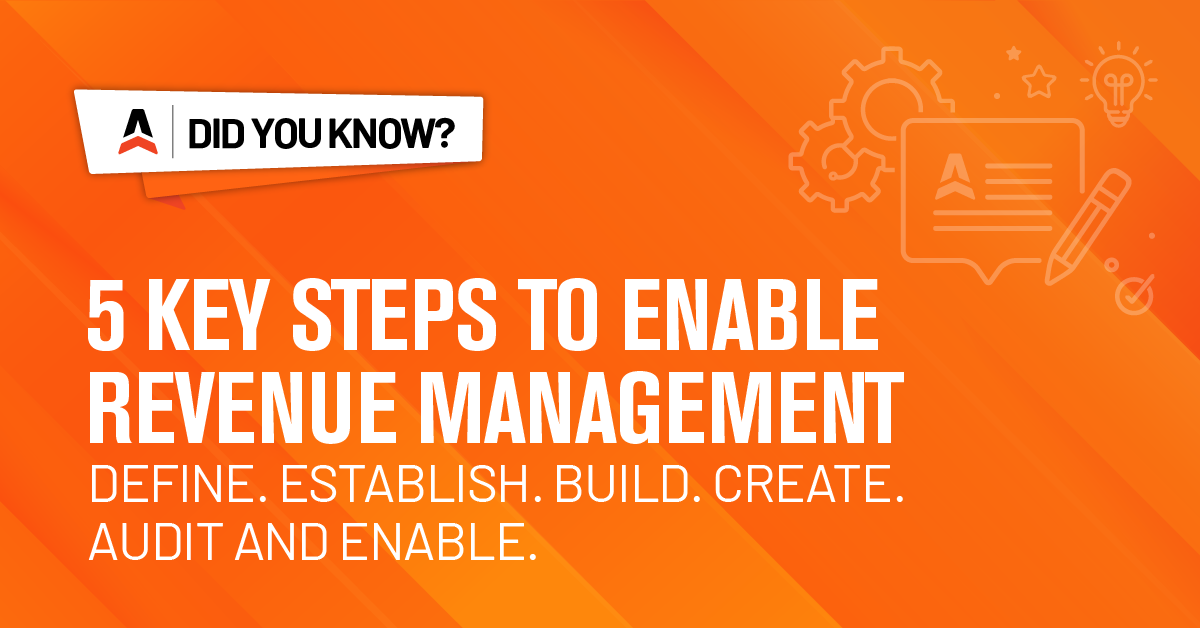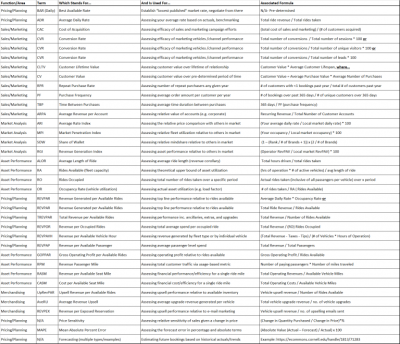5 Key Steps to Enable Revenue Management (RM)

First, before you begin with the following steps below, it is essential to note that the practice of revenue management (RM) is not a one-time endeavor, nor is it is not a one-size-fits-all. It requires continuous analysis, trial and error, and refinement to facilitate a process of constant improvement through continuous feedback. It is not a philosophy, it is a discipline and requires a culture of curiosity and accountability.
Not surprisingly, there are many similarities between ground transportation and other travel verticals (in RM) such as airlines, hotels, rental cars, cruise lines, and ferry lines. They are:
- All perishable products
- Multiple service types/levels
- Identical or similar distribution channels
- Identical or similar types of buyers (leisure, corporate)
- Identical or similar demand influencers (e.g., special events, seasonality, etc.)
However, there are also many challenges in employing RM with ground transportation companies:
- Due to heavy reliance upon affiliate networks, actual capacity can be hard to ascertain (e.g., asynchronous or opaque supply in affiliate networks)
- Traveler behavior in this product line skews towards last-minute window (unlike other travel product lines that have already been booked)1
- Competitive benchmarks are not always easy to assemble quickly, nor might it be representative of the actual market rate (limited by their own sophistication).
- Unlike hotels or cruise lines, inventory is frequently mobile, which can impact pricing depending on the location of demand, which therefore requires dynamic fleet positioning/allocation planning2
- Unlike major hotel chains or airlines, the majority of operators lack the leverage to negotiate floating rates with TMC’s corporations and therefore are limited to BAR + discount, exposing margin.
- Pricing models tend to be more simplistic, limiting levers to influence demand (e.g., ancillaries, cancelation policies, pre-pay discounts, etc.)
Below are the primary steps required to incorporate revenue management activities into your business:
- Define your objectives within the revenue management realm (goals)
- Establish a feedback loop that helps you understand buyer behavior AND what is influencing it (influencers)
- Build a routine for assessing performance amongst relevant metrics (levers)
- Create a systematic way of analyzing key performance indicators (KPI’s) to assess and predict performance along with established metrics (commonly used KPI’s) to gauge efficacy (metrics) continuously
- Audit and enable capabilities necessary to employ revenue management based upon established objectives, influencers, levers, and benchmarks (tools)
Analyze. Plan. Deploy. Measure. Refine. Repeat. Expand: Define your objectives within the revenue management realm (goals)
- Do I want to increase my upsell take rate?
- Do I want to increase my cross-sell take rate?
- Do I want to smooth demand (e.g., advanced purchase)?
- Do I want to steer demand (e.g., to my direct channels)?
- Do I want to maximize the underutilized portion of my fleet?
- Do I want to improve the performance of underperforming fleet types?
- Do I want to improve my peak time revenue?
- Do I want to increase penetration/yield in the sub-segment?
- Do I want to align pricing with seasonality better
- Do I want to increase share of wallet with customers?
Establish a feedback loop that helps you understand buyer behavior AND what can impact it (influencers)
- Seasonal demand
- Local activities or events
- Competitive pricing/coverage
- Traffic/construction
- Weather / environmental
- Geopolitical
Build a routine for assessing performance amongst relevant metrics (levers)
- Fleet coverage/composite
- Rate structure(s)/rules(s)
- Booking policies
- Hours of operation
- Maintenance schedule
- Ancillary offering(s)
- Supply (driver) availability/constraints
- Vehicle positioning / idle time
- Distribution channel performance
- Call center
- Web site
- Mobile app
- 3rd party (e.g., agents, affiliates, aggregators, TMC’s/CBT’s)
- Sales and Marketing channel performance
- Social
- Search
- Sales
- SMS
Create a systematic way of analyzing the above to assess and predict performance along with established KPI’s (key performance indicators) to gauge efficacy continuously (metrics)

- Additional forecasting considerations:
- Consider simplifying vehicle classes, segments, and rate types to improve forecast. [4]
- Understand “unconstrained demand”, i.e., forecast not bound by rates or fleet capacity (upper bound of theoretical demand, imperative for when demand exceeds supply)[5]
- Let unconstrained demand forecast “inform” business forecast (which is based on constrained or “truncated” demand, i.e., bound by rate/fleet limitations)[6]
- Frequency of updates – if/when pricing and/or forecast feedback generate results that appear off the mark, quickly refine and update (should be a continuous feedback/adjustment loop).
- Calibrate external factors – keep a close eye on external factors, they can impact your forecasts, weed out the noise, incorporate new influencers (refine the model)
- Determine appropriate timescale – ensure horizon is far enough in advance to allow you to react to changes and captures breadth/depth of booking patterns[7]
Audit and enable capabilities necessary to employ revenue management based upon established objectives, influencers, levers, and benchmarks (tools)
- Determine what is acceptable to be performed manually vs. where automation is necessary.
- It should be noted that manual processes can, and in many cases should, be a viable approach for trial before investing in automation, or in cases where intervention required is relatively infrequent.
- Once levers yield anticipated results, further investment can be made, and other objectives can be pursued.
- Two primary (and interrelated) areas where technology can aid revenue management:
- Reporting & Analytics
- Benchmarking, KPI reports, resource/asset management, forecasting, etc.
- Pricing & Promotion
- Criteria based pricing, peak time pricing, cross sell/upsell logic, payment term enforcement, channel management, etc.
- Reporting & Analytics
In summary, incorporating revenue management into your business should advance incrementally, requires consistent testing and learning, and a concerted/routine focus on internal and external metrics.
Here are a few final suggestions to tighten and optimize business practices to enable RM objectives:
- Ensure you have internal accountability assigned to RM owner to spearhead the effort
- Planning requires cross-functional input (sales, marketing, operations, finance, etc.)
- Consider centralizing/aggregating data for ease of analysis and east of access
- Informally poll your customers to gauge future travel intent to aid in the planning process
- Understand how pricing can be used as a lever to influence buyer behavior (e.g., throttling minimum ride times or increase pricing during peak times to avoid revenue dilution, decrease pricing during off-peak times to maximize fleet utilization, encourage advanced purchase through discounts to smooth demand/booking pace). [3]
Useful Sources/Citations:
[1, 2, 3, 4] Why It Is Difficult to Apply Revenue Management Techniques to the Car Rental Business and What Can Be Done About It, Robert F. Gordon, Proceedings of the Northeast Business & Economics Association 42nd Annual Conference, Jamaica, New York, November 5-7, 2015, pp. 135-138
- [5] The Key to Profitability: Understand Your Demand Forecast By Dan Skodol, VP, Data Science & Analytics at Cendyn
- https://www.hospitalitynet.org/opinion/4094524.html
- [6]https://revenue-hub.com/revenue-management-forecast-vs-business-forecast/
- [7]https://revenue-hub.com/revenue-stream-forecasting-trm/
- https://www.readyratios.com/reference/analysis/price_sensitivity.html
- https://gocardless.com/en-us/guides/posts/share-of-wallet-sow/
- https://www.revfine.com/what-is-revenue-management/
- https://www.revfine.com/revenue-management-kpis-hotels/
- https://www.revfine.com/hotel-kpis-upsell-marketing-performance/
- https://www.revfine.com/category/revenue-management-kpi/
- https://www.rate-wise.com/blog/revenue-management-terms-made-simple
- https://www.altexsoft.com/blog/revpar-occupancy-rate-adr-hotel-metrics/
- https://www.altexsoft.com/blog/business/hotel-revenue-management-solutions-best-practices-revenue-managers-role/
- https://blog.useproof.com/calculate-conversion-rate
- https://blog.hubspot.com/service/how-to-calculate-customer-lifetime-value
- https://www.profitwell.com/recur/all/calculate-and-reduce-cac
- https://blog.smile.io/how-to-calculate-purchase-frequency/
- https://www.demandplanner.com/five-tips-improve-demand-forecasting-accuracy/


